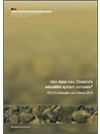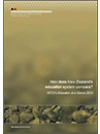Every year, the Organisation for Economic Cooperation and Development (OECD) publishes "Education at a Glance", a set of indicators that compares the education systems of its member countries, and participating partner countries.
The report "How does New Zealand's education system compare?" draws on the New Zealand data in Education at a Glance 2010 and summarises the characteristics and performance of New Zealand's education system in an international context.
Purpose
The OECD publication Education at a Glance 2010 (EAG 2010) compares education systems across the OECD for the year 2008
Key Results
- New Zealand’s investment in education is below the OECD average in per student terms, yet forms an above average share of GDP. Our relative wealth and demographic structure lie behind these apparently differing results. When compared to GDP per capita, expenditure per student it is closer to, though below average. Of government expenditure, a relatively high proportion is devoted to education. Government education spending represents an above average percentage of GDP, particularly at tertiary level where it includes a high proportion of student support.
- Base teacher salaries compare favourably with those of OECD counterparts in benchmarks OECD uses, though are below OECD averages in absolute terms. New Zealand student to teacher ratios compare favourably with OECD average levels at pre-primary and upper secondary levels, but are higher at other levels of education.
- More of our under fives are in early childhood education, and more of our adults are in post-secondary education, than in other OECD countries, but fewer of our 15 to 19 year-olds are enrolled beyond the first year of upper secondary.
- While more of our 15 to 19 year-olds leave school with less than year 12 qualifications, they are more likely to be working or enrolling in post-secondary study. New Zealand, however, still has one of the higher proportions of 15 to 19 year-olds neither in employment nor education. Many of this group will enrol in post-secondary study later.
- New Zealand has a high percentage of its population that enters tertiary study, particularly at older ages. The entry rate to diploma level study, especially, is one of the highest in the OECD. While entry is high, New Zealand also has one of the highest rates of part-time study. While those studying full-time are as likely to complete their qualification as full-timers in other OECD countries, fewer part-timers complete their qualification. When full-time and part-time students are combined, the rate of qualification completion is low when compared to other countries where full-time study is more common. When adjusted for international and older graduates, the rate at which the country produces tertiary-qualified graduates is about average. By age 29, New Zealanders have spent about as much time in education as the OECD average.
- Overall, New Zealand has a high proportion of tertiary qualified adults – in particular, a very high proportion with vocational qualifications. Although not included in EAG, this is aided by a high proportion of recent immigrants with tertiary qualifications. Despite high levels of tertiary qualified adults, one in five adults aged 25 to 34 years does not have a year 12-equivalent school qualification or higher, a rate which is about the OECD average, but higher than some countries we might normally compare with.
- As with all countries in the OECD, employment and earnings increase with level of education, but New Zealand has one of the smallest differences in employment or earnings between adults with school and adults with tertiary qualifications, in particular diplomas. Private and public returns for investing in a tertiary education are also lower, as are labour costs. New Zealand is in a group of countries, including Scandinavian countries and Australia, which have higher levels of tertiary qualified adults, and lower returns.
- Health status and interest in politics in New Zealand increase with level of education as in other OECD countries. New Zealand has one of the highest levels of self-reported health status across any level of education, and the smallest difference between least and most educated. We also have a more uniform interest in politics; New Zealanders with low qualifications have more interest in politics than similarly-educated adults in other countries, while tertiary educated adults have less; and overall, we are about average.
- New Zealand is a net importer of tertiary students; many more come to NZ for tertiary study than leave NZ for tertiary study overseas. While numbers declined at diploma and degree level between 2005 and 2008, they increased at postgraduate levels – dramatically so at doctorate level. In 2008, we had the fifth highest proportion of our tertiary student body that came from overseas and we were the 12th largest market in absolute market share terms. Fewer than 5,000 NZ citizens were recorded as studying overseas – nearly half of these in Australia, and nearly 90% when the United States, United Kingdom and Canada are added.


